3/26/2014
Controlling This Season’s Scourges
Jennifer Zurko
Tobacco Mosaic Virus (TMV)
Margery Daughtrey | Long Island Horticultural Research & Extension Center for Cornell University
1. What crops does it affect?
Tobacco mosaic virus (TMV) is a virus with a large host range, including many ornamentals, as well as plants in the Solanaceae family, such as tobacco, tomato and pepper. In our world of greenhouse ornamentals, TMV has been a problem primarily on petunias in the last 20 years, dating back to the introduction of vegetatively propagated petunias. An Ohio-ARS research team (Lewandowski, Hayes and Adkins, 2010) found that a strain of TMV originating from petunia caused particularly strong mosaic symptoms in petunia, while other species in the same virus family could in some cases infect petunias without causing symptoms. Tomato mosaic virus (ToMV), for example, is a scourge of tomatoes that can infect petunias—causing symptoms in some petunia cultivars, but not others. (Petunias thus could carry ToMV symptomlessly and endanger tomatoes in the same greenhouse).
 Pictured:Symptoms of Tobacco Mosaic Virus (TMV) are leaf strapping …stunting … and a yellow mosaic pattern on the leaves.
Pictured:Symptoms of Tobacco Mosaic Virus (TMV) are leaf strapping …stunting … and a yellow mosaic pattern on the leaves.
In experimentation reported from the U.K. (Spence et al, 2001), both verbena and calibrachoa developed systemic mosaic when inoculated with a petunia strain of TMV. Some other bedding plant species were also infected, including bacopa, convolvulus, diascia, felicia and fuchsia. Of these, diascia showed necrotic local lesions, while the other infected plants tested positive for TMV by the ELISA (enzyme-linked immunosorbent assay) test, but were symptom-free. This same isolate of petunia TMV didn’t cause infection when inoculated onto snapdragon, bidens, brachycome, geranium, helichrysum, impatiens, lamium, lysimachia, marguerite, mentha or nepeta. Generalizations are difficult because different isolates of TMV and different plant cultivars may interact differently. Additional research would be helpful for giving growers more knowledge of what crops would be least likely to be affected by TMV causing mosaic in petunia.
2. How do you detect it?
Virus symptoms are notoriously hard to identify just by looking—they can be mimicked by genetic variegation or by certain other diseases or disorders, even spray injury. Plus, one virus disease can easily be mistaken for another. To identify TMV, start by looking for mottling or mosaic in leaves, yellowing or browning of veins, leaf strapping, stunting or dieback of plants. Then confirmation of the disease can be done at a university or private diagnostic lab, or on-premises using a test kit, such as the immunostrips sold by Agdia, Inc.
3. What type of damage does it do?
TMV on petunias may cause stunting, a necrotic tip dieback, mosaic, strapped leaves and yellowing along veins. Color break in flower petals and rat-tailing (leaves abruptly tapering off with a narrow tip) are seen at times. Infected plants may be mildly symptomatic or severely disfigured. The most damaging feature of TMV is its highly contagious nature and this harms the peace of mind of any grower encountering it.
4. How can you control it?
Virus infections cannot be “controlled” in any very satisfying sense. The infections by TMV are systemic and an infected plant cannot be cured. Control for TMV is a matter of squelching spread. Without a concerted effort to stop spread, a small number of infected plants can quickly progress to a high percentage. This season, many growers are using nonfat dry milk as a spray prior to transplanting petunias. Milk is relied upon in the tobacco industry for inactivation of virus during transplant and was shown to be very effective at reducing virus transmission to petunias via cutting tools (Lewandowski et al., 2010). The component of milk responsible for the anti-TMV benefit is not understood. TMV persists on inanimate surfaces in the greenhouse and must be inactivated with nonfat dry milk, a 1:9 dilution of bleach, Virkon S or some other effective surface disinfestant.
5. How can you prevent it?
Prevention is key. Any ornamentals grown from cuttings highly susceptible to TMV (think petunias, calibrachoas and verbenas, in particular) need to be produced in meticulous clean stock programs. TMV must be excluded from the stock plant area by very careful sanitation and testing procedures. Incoming plant material must be carefully screened. Even seed can be a source of TMV, as the seed coat may be externally contaminated and then infect a seedling through minor wounds made during germination.
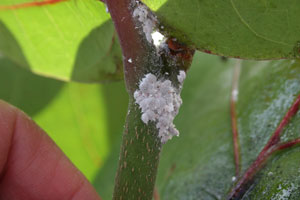 Mealybugs
Mealybugs
Dr. Raymond A. Cloyd | Kansas State University
1. What crops do they affect?
Mealybugs, depending on the particular species, feed on a wide-range of plants—including herbaceous annuals and perennials, foliage/tropicals, orchids, vegetables and herbs.
2. How do you detect them?
Mealybugs don’t fly, except for the adult male, so they’re not captured on yellow sticky cards. Visual plant inspections are the only way to detect early mealybug infestations. Because of their cryptic behavior and small size (especially the early instar crawlers), scouting via visual inspections is labor intensive and may be impractical. Scouting efforts should focus on plant species that are known to be highly susceptible to mealybugs. This can be done by tagging a number of plants (five to 10 per plant species) and inspecting them regularly. This may help detect mealybug populations early. Workers should wear disposable rubber gloves when handling highly susceptible plants.
Pictured: Visual plant inspections are the only way to detect early mealybug infestations
3. What type of damage do they do?
Mealybugs are phloem-feeding insect pests and cause direct plant injury/damage by feeding on plant fluids or sap in the vascular tissues—primarily the phloem or mesophyll or both—with their piercing/sucking mouthparts. They can also inject toxins into plants. Direct feeding damage includes leaf yellowing, plant stunting and wilting. In addition, mealybugs excrete a clear sticky liquid called honeydew, which serves as a growing medium for black sooty mold fungi.
4. How can you control them?
Suppression of mealybug populations involves a holistic approach via the implementation of a variety of management strategies, including cultural, sanitation, insecticidal and biological. The first line of defense is sanitation that includes weed removal, discarding old plant material and heavily-infested plant material. Insecticides must be applied early when the crawlers are present because adults form a white, waxy protective covering that’s almost impervious to most contact insecticides. Frequent applications are required to achieve satisfactory suppression, especially when dealing with overlapping generations. The crawler stage doesn’t possess a waxy covering, which means it’s susceptible to many different types of insecticides, including insect growth regulators, insecticidal soaps and horticultural oils.
When applying high-volume sprays, thorough coverage of all plant parts is essential when using contact insecticides, as mealybugs are commonly located in areas that aren’t easily accessible, such as the base of leaf petioles, leaf sheaths and leaf undersides. It’s also recommended to make multiple applications when crawlers are present because eggs will hatch over an extended time period. Biological control agents are commercially available for use against mealybugs—particularly the citrus mealybug—such as the predatory ladybird beetle, Cryptolaemus montrouzieri, referred to as the “mealybug destroyer,” and the parasitoid, Leptomastix dactylopii. Both biological control agents may be effective in suppressing citrus mealybug populations and they can be used together under certain systems and circumstances.
5. How can you prevent them?
It’s difficult to prevent mealybug infestations or populations from becoming established due to their small size and capacity to feed on a wide assortment of plant species. It’s always important, if practical, to inspect shipments of highly susceptible plants (e.g., coleus) before introducing into the main crops.
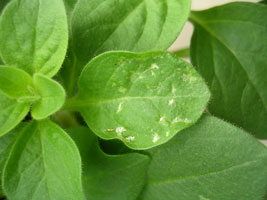 Western Flower Thrips (WFT)
Western Flower Thrips (WFT)
Steven Frank | Assistant Professor and Extension Specialist in the Entomology Department at North Carolina State University
1. What crops do they affect?
Western flower thrips (Frankliniella occidentalis) is probably the most damaging greenhouse pest in the world, damaging hundreds of ornamental and vegetable crops. Among ornamental crops, many bedding plants (e.g., petunia, impatiens, pansy), cut flowers (e.g., roses), foliage plants and perennials are favorite hosts.
2. How do you detect them?
WFT can be detected by yellow sticky cards, which capture the flying adults. Cards should be hung just above the plant canopy and inspected often to count and record thrips abundance. In many cases, just a few thrips can justify corrective action.
Pictured: Western flower thrips scrape plant tissue, then suck the juices that are released, leaving abraded patches of tissue that eventually become silvery.
3. What type of damage do they do?
WFT feed on leaves and flowers. They scrape plant tissue, then suck the juices that are released. This leaves abraded patches of tissue that eventually become silvery. Thrips also leave small black fecal pellets at these feeding sites. When thrips feed on flower petals, they cause streaked discoloration. When thrips feed on young leaves or meristems, the leaves become distorted as they grow. This is because the feeding damages some of the cells in the leaves so, as most of the leaf cells expand, some cells do not, resulting in crinkled, deformed leaves.
4. How can you control them?
Thrips can be controlled with insecticides containing spinosad, abamectin, acephate, bifenthrin and others. Thrips can also be managed using biological control organisms. The fungus Beauveria bassiana can be used to kill thrips. It’s mixed and sprayed similarly to conventional insecticides. However, it’s a fungus that feeds on thrips and kills them. Other organisms—such as the predatory mites Amblyseius cucumeris and Amblyseius degenerans or the predatory bug Orius insidiosus—can be purchased from commercial suppliers and released. Nematodes in the genus Steinernema are also used to manage thrips.
5. How can you prevent them?
Prevention of thrips starts with sanitation and greenhouse construction. Thrips can reproduce on almost any weeds growing in or around your greenhouse. They pupate in soil, so accumulations of soil on the greenhouse floor can also promote thrips. Thrips screening over windows, fans and vents will reduce the number that enter the greenhouse.
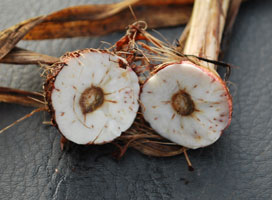 Fusarium
Fusarium
Ann Chase | Chase Agricultural Consulting LLC
In the 35 years I’ve been studying diseases of ornamentals, I’ve come to the conclusion that Fusarium is one of the hardest pathogens to control. This is even true when plants are treated preventatively, well before infection. The fungicides that are somewhat effective on Fusarium aren’t 100% effective, even when used preventatively. This makes cultural controls very critical, including starting with healthy cuttings or transplants. Fusarium spores move easily with water and can be splashed from one plant to another. They often appear in propagation as cutting rot and aren’t always the primary pathogen involved. That means Fusarium can attack plants weakened by other fungi and bacteria or those stressed by cultural or environmental problems.
Pictured: Fusarium wilt on crocosmia showing vascular browning.
1. What symptoms does it cause?
Black or brown sunken lesions at the base of the stem and stem cankers with orange or red fruiting bodies. Fusarium can cause a multitude of symptoms from leaf spots (dracaena), to cutting rot (phormium and mandevilla), crown rot (liriope, ophiopogon and lisianthus), wilt (mums, carnation and cyclamen), bulb rot (gladiolus and caladium) and even root rot. Wilt diseases are usually caused by Fusarium oxysporum with a separate type for each type of plant attacked. Symptoms of stunting, wilting and yellowing are common on plants with Fusarium wilt. Leaf spots on dracaena are caused by F. moniliforme and crown rot is often caused by F. solani.
2. What crops does it affect?
Fusarium most often is described as causing wilt diseases. Some of the many crops that can be infected by a form of Fusarium wilt are cyclamen, carnation, mum, many bulb/corm crops like iris, daffodil and gladiolus, and even vegetables like tomato. The Fusarium wilt diseases are caused by F. oxsporum formae specialis (fsp.). Each plant or family of plants is affected by a distinct and different fsp. Thus, Fusarium wilt on carnation infects dianthus, but not gladiolus, which is infected by a different Fusarium oxysporum.
Crown/stem and bulb or root rot diseases caused by Fusarium spp. are far more common and are often the result of infected propagative materials. They’re also often caused by using the wrong cultural conditions for the crop. For instance, Fusarium stem rot on succulents and cacti is nearly always the result of too much water and/or fertilizer. Cutting rot is very common in propagation of some woody ornamentals, where many plants might develop disease when grown badly. In other cases, the plant is especially susceptible. Mandevilla are attacked by both a stem rot Fusarium (like F. solani) and a Fusarum wilt (F. oxysporum).
One of the most unusual Fusarium diseases is Fusarium leaf spot, which can occur on dracaenas. The spots form in the whorl of the plants and don’t happen at all when the whorl is kept dry. The cause is Fusarium moniliforme.
3. How do you detect it?
Infection with Fusarium wilt is often confirmed when the stem or bulb is cut to reveal vascular streaking in the xylem. Stem or corm rot is most likely accompanied by a dry rot (usually not smelly) that may have spores on the outside that are white to pink to orange in color. When the perfect stage of the Fusarium is formed, reddish-orange spheres (fruiting bodies) can also form. In the final analysis, getting a lab confirmation is really helpful.
4. How can you control it?
There are a number of somewhat effective products that are used preventatively for Fusairum diseases. Unless you’re able to correct cultural deficiencies, no fungicide will correct a Fusarium disease. Biological agents like actinomycetes (Actinovate and Mycostop) can be effective in some cases. Use of azoxystrobin (Heritage and other strobilurins), fludioxonil (Medallion or Palladium), triflumizole (Terraguard) and, to a lesser degree, thiophanate methyl (3336, OHP-6672 and others) are usually the most effective fungicides. For leaf spot on tropicals like dracaenas, chlorothalonil (like Daconil) and iprodione (like Chipco 26019) are very effective.
In one study we conducted with an orchid grower, disease was reduced by more than 80% when the fungicides were used less often at the optimal rate. This is a pattern we’ve seen several times with Fusarium. It’s important to use the most effective rate (often the highest on a label) on the longest interval. This goes against our intuition, but it’s the most effective.
5. How can you prevent it?
Never use infected cuttings or dip them into a fungicide bath (this spreads spores very effectively making the entire batch contaminated). Don’t overwater or use a poorly draining potting medium. Don’t plant in ground beds that have become contaminated from a previous crop. Don’t use pots or flats without a thorough cleaning and disinfecting and never re-use potting media. Avoid using ammoniacal nitrogen or too much nitrogen on plants that are susceptible to Fusarium wilt.
Conclusions
If you have a crop that’s affected by a Fusarium disease, start first with the propagation material you’re using and next examine your culture of the crop. You can use fungicides, but they won’t correct the effects of using infected bulbs or cuttings or bad cultural conditions.
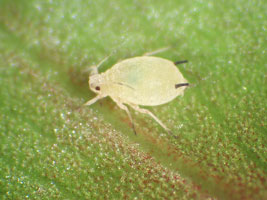 Aphids
Aphids
Suzanne Wainwright-Evans | Buglady Consulting
The talk of the town used to be all about thrips; these days, aphids are stealing some of the light. They can be one of the more obvious pests because of their high numbers and colors. In northern parts of the U.S., they’re mostly an issue in the spring and summer, but in southern areas they can be an issue year-round.
Identification—Small (1 to 10 mm) and pear shaped. Their color varies by species and there can be color morphs (different colors within a species). The more common colors are green, dark pink, yellow or even black. Many are smooth and shiny, but some of the more ornate or “woolly” aphids can have white fluff similar to that of mealybugs.
Aphids have cornicles—two “tail pipes” that extend from the end of their bodies. They can excrete alarm pheromones in response to being attacked by predators. Most often, aphids are found wingless, but sometimes they will have wings. This happens when populations grow too large for the plant to support the aphid colony. So to elevate this overcrowding, some of the aphids will develop wings, helping them to fly away to new food sources.
Damage—Aphids don’t cause chewing damage like other insects. They have mouth parts that are somewhat like a turkey baster, piercing the plant material then sucking out phloem sap. If there are just a few aphids around they usually don’t cause too much damage, but as a population grows, they can cause leaf curling, stunted growth and even yellowing. This can happen quite quickly, so when aphids are found, they should not be ignored.
If they’re left to let their populations grow, which they can rather quickly, other symptoms can develop. Leaves and stems below the aphid population develop the appearance of being wet, and when touched, very sticky. This is “honeydew.” As aphids feed, they take up large amounts of sugar that can’t all be used by the insect, so the excess sugar is excreted as droplets. If the aphids go untreated, this honeydew will build up and an opportunistic black mold will grow on these sugars. This “sooty mold” doesn’t harm the plant, but is an aesthetic problem. With treatment of
the aphids, this black mold will just wash off the plant, not needing a fungicidal
treatment.
Almost all aphids in a colony are parthogenetic (can reproduce without mating) and produce live offspring. The newly born aphids are clones of their mothers and wingless. These aphids will feed, molting four times before becoming an adult. When they molt, they leave behind their old skins on the surface of the plant material, looking like white flakes. This can easily be mistaken for whiteflies or other pests, so use your 10x hand lens to confirm identification.
Control—Aphids come every year, so growers should be ready for them. The first step to control is prevention. This can be done by inspecting your cutting and plugs for pests when they arrive. If taking your own cuttings, keep your mother stock plants clean. Keeping weeds under control is also an important step to helping mange many pests, not just aphids.
One nice thing about aphids is they have a lot of natural enemies out there. Ladybugs, lacewings, fly larva, wasps, true bugs and many others love to feed on these soft-bodied insects. Tiny parasitic wasps (2 mm) in the genus Aphidius are one of the more commonly occurring beneficials for aphid control and are often misidentified. These adult female wasps are not much larger than an aphid. Once she finds her prey, she inserts an egg inside the aphid’s body. The egg hatches and the immature wasp larva feeds on the aphids non-essential parts. After about seven days, the aphid begins to swell and turns light brown in color. This is called an aphid mummy. Approximately four days later, the wasp from inside the mummy chews a hole in the back of the aphid, climbs out and flies off. Depending on species, this cycle takes around two weeks. The adult wasps can then live for several weeks.
Aphelinus abdominalis is another parasite that works in a similar way as Aphidius sp., but the dead aphid turns black instead of light brown. Also they will “host feed” on the aphids. The female wasp stings and paralyzes an aphid, then stabs holes in the immobilized body. These holes will leak body fluids and the adult wasp will drink them up.
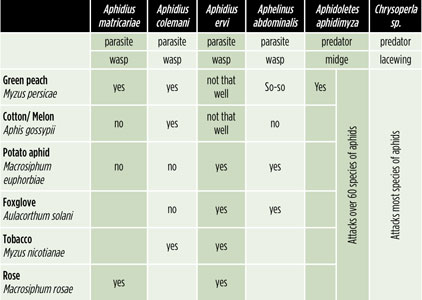
If you’re not lucky enough to have these beneficials naturally occurring, they’re commercially available from several different companies that produce beneficials for aphids. Applied Bionomics, Beneficial Insectary, BioBest Biological Systems, Koppert Biological Systems and Syngenta BioLine all produce insects for the control of aphids.
To help keep aphid parasites and predator populations up, many growers have moved to using a aphid banker plant system. The plant used in this system is barley. The barley is inoculated with the bird-cherry aphid, Rhopalosiphum padi (Linnaeus). This aphid establishes well on the barley and will not move to most other ornamental crops. The aphid population on the barley (while kept isolated) is allowed to build to high numbers and then moved into the growing area. The plant is then inoculated with one of the beneficials, like the parasitic wasps A. colemani. With the plants in the crop production areas, the beneficials can leave the barley plant to look for pests in the crops. If the crops are clean of aphids, they can return to the banker plant where there’s a meal of bird-cherry aphids waiting. This allows for effective pest control in the crops, using fewer releases of biological control agents during the growing season.
If biologicals aren’t right for you, there are several pesticides labeled for aphids. Aphids don’t have hard bodies like many other insects, so they’re easy to kill. Softer products like insecticidal soap and oils kill aphids on contact, but you must get the spray coverage. Remember, leaving just one aphid can lead you right back into problems; she doesn’t have to mate to have babies. Systemic pesticides, like neonicotinoids, can be another option to provide a longer period of control, but can impact your populations of beneficials. There are several pyrethroids that are labeled for aphids also, but if planning any kind of biological control program, once sprayed, these pyrethroids can impact some beneficial species for up to 60 days.
There are some pesticides that are softer on the beneficials, so they can be used to knock down aphid populations prior to the release of beneficials. Products that contain active ingredients like Beauveria bassiana or azadirachtin, and products like Endeavor (pymetrozine), which only kills aphids and whiteflies, can help preserve many of the beneficials. GT